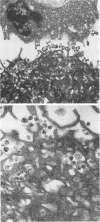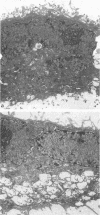Abstract
The human cervix-derived epithelial cell line (ME180) used in this study displays a characteristics epithelial morphology, including numerous desmosomes, tonofilaments, and epidermal filaments. When T-cell lines infected with human immunodeficiency virus (HIV) are added to epithelial cultures, they rapidly adhere to the epithelial monolayer. Within a few minutes, the T cells shed numerous virions into narrow spaces formed between the epithelial cell and the adherent T cells. Virions subsequently enter the ME180 cells via large vesicles. A few days after infection, cytopathic effects and syncytium formation were observed. Infected clones of ME180 cells have remained infected for 8 months. p24 enzyme-linked immunosorbent assay and infectivity assays show that one subclone of the cell line produces virus titers equivalent to those of high-secreting HIV-infected T-cell lines. Electron microscopy reveals numerous virions budding from both the basal and apical surfaces of the epithelium. These observations suggest that cervical epithelium has the potential to serve as a site of HIV infection.
Full text
PDF
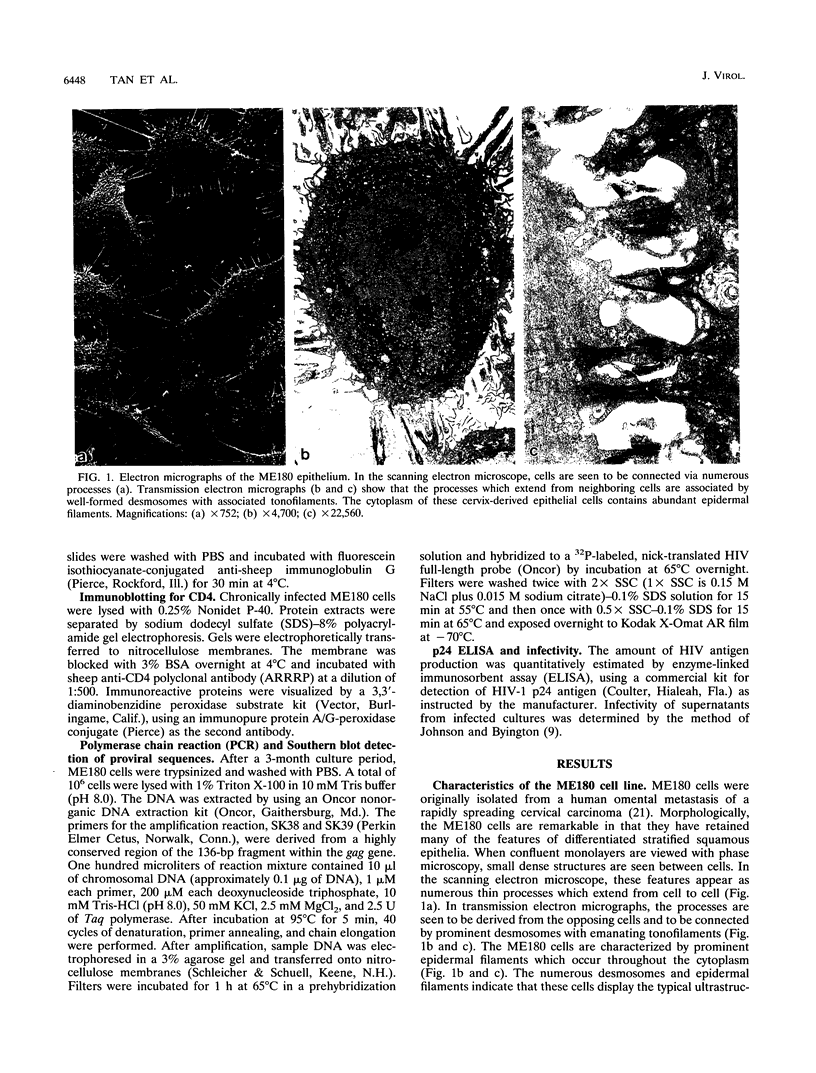
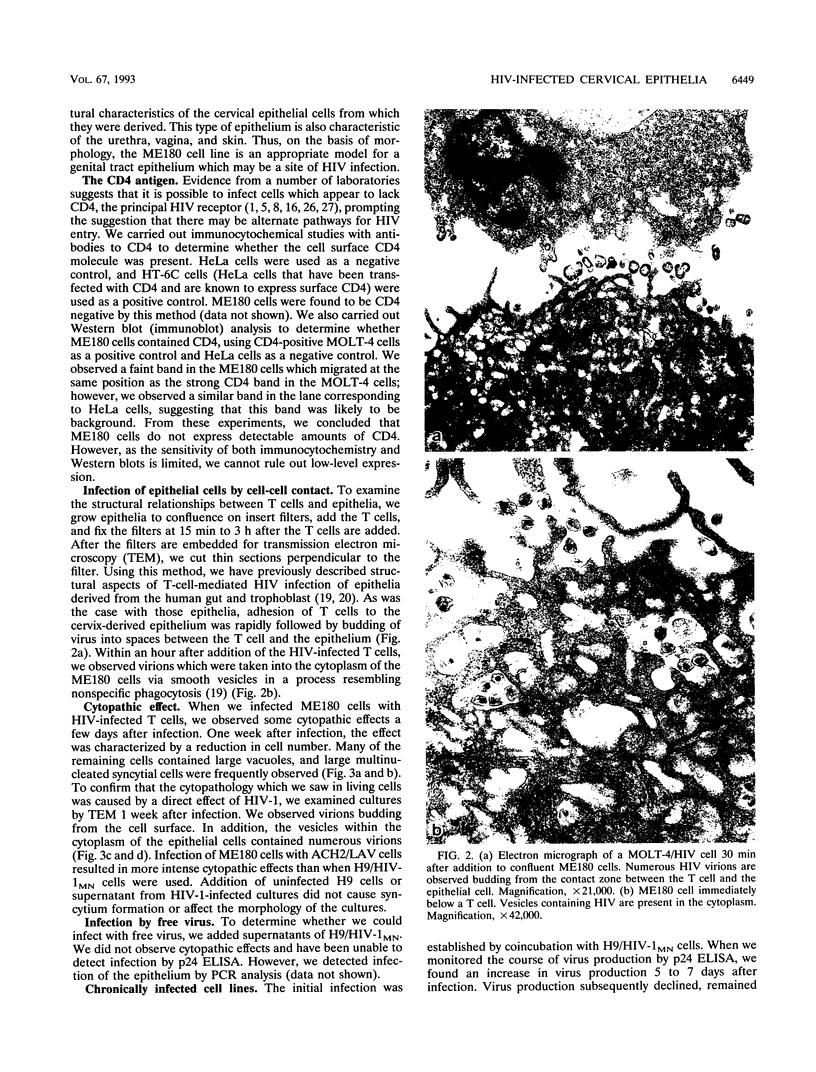
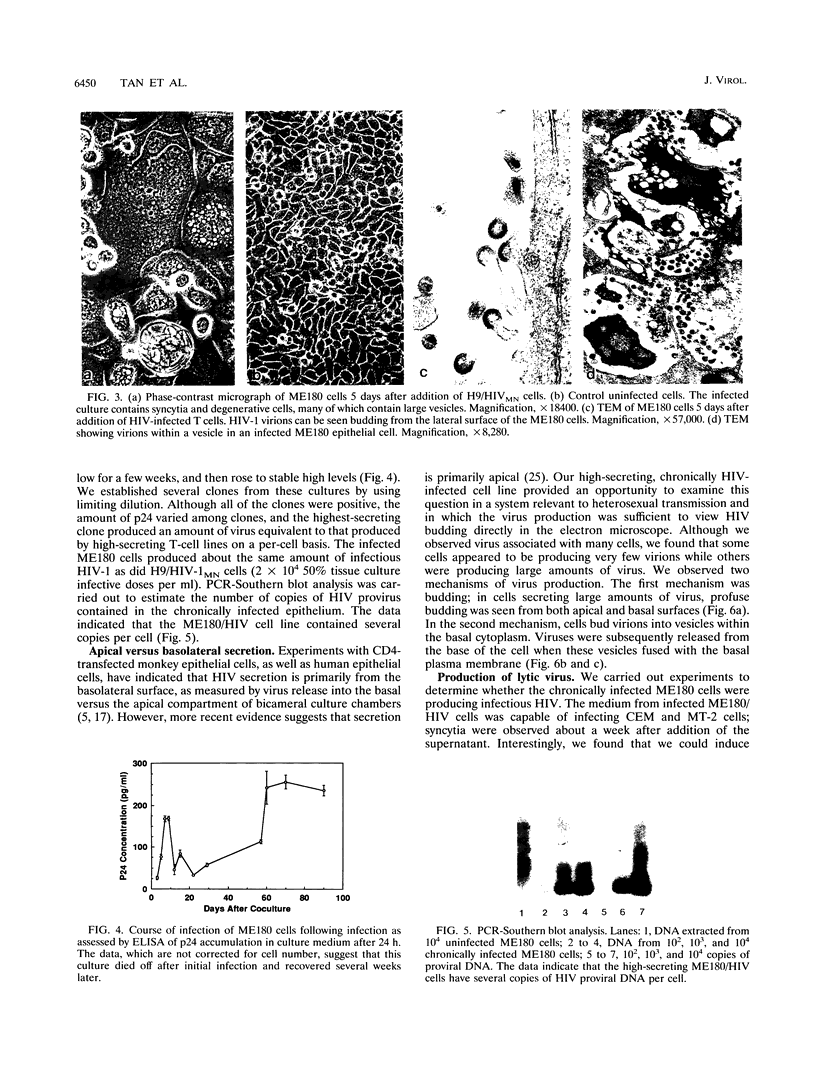
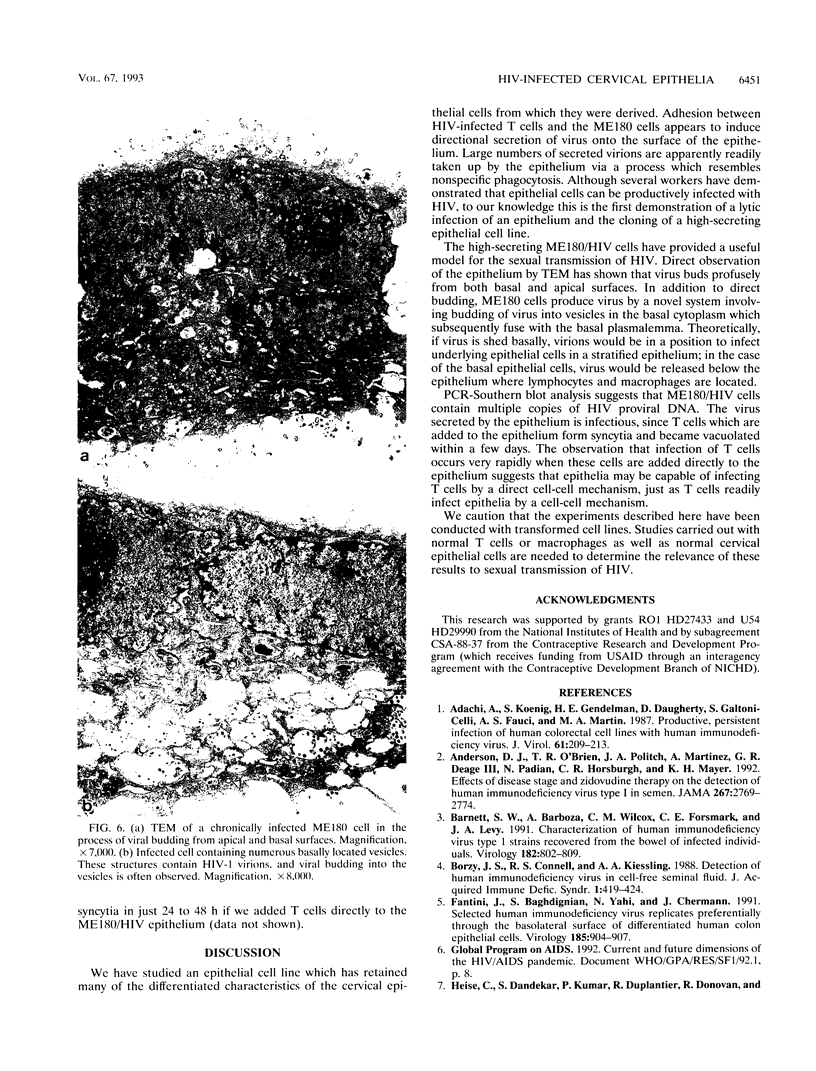
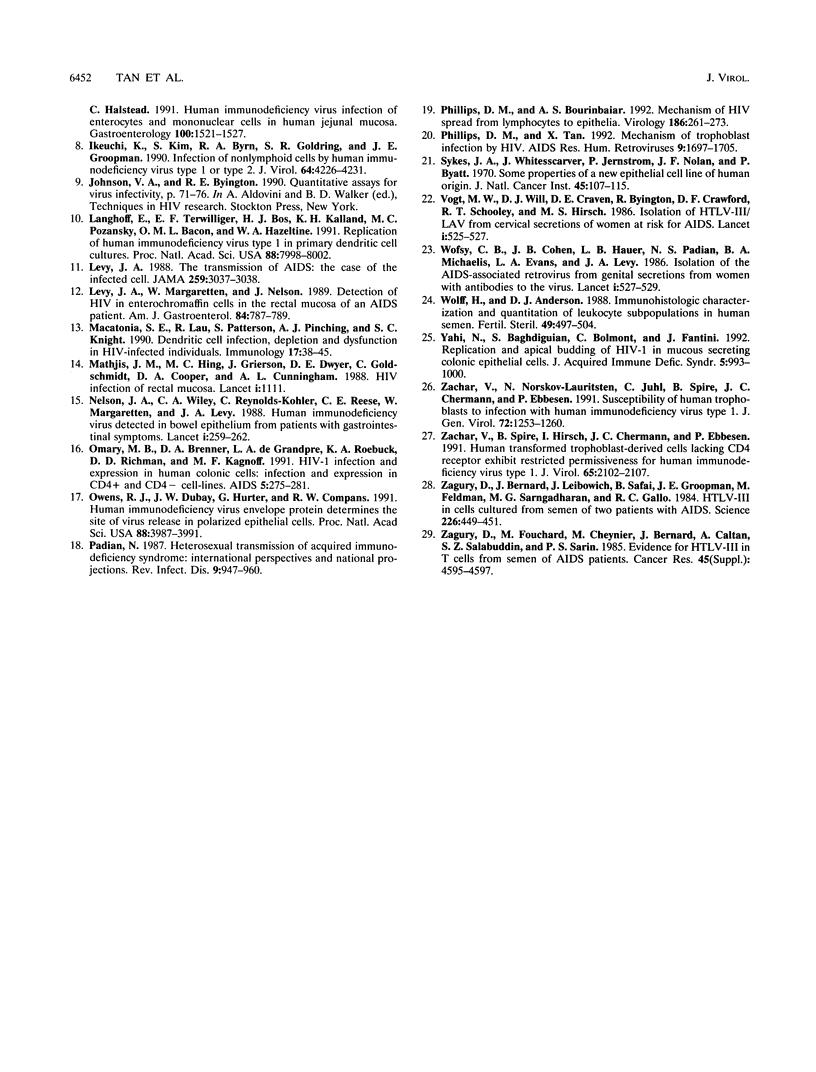
Images in this article
Selected References
These references are in PubMed. This may not be the complete list of references from this article.
- Adachi A., Koenig S., Gendelman H. E., Daugherty D., Gattoni-Celli S., Fauci A. S., Martin M. A. Productive, persistent infection of human colorectal cell lines with human immunodeficiency virus. J Virol. 1987 Jan;61(1):209–213. doi: 10.1128/jvi.61.1.209-213.1987. [DOI] [PMC free article] [PubMed] [Google Scholar]
- Anderson D. J., O'Brien T. R., Politch J. A., Martinez A., Seage G. R., 3rd, Padian N., Horsburgh C. R., Jr, Mayer K. H. Effects of disease stage and zidovudine therapy on the detection of human immunodeficiency virus type 1 in semen. JAMA. 1992 May 27;267(20):2769–2774. [PubMed] [Google Scholar]
- Barnett S. W., Barboza A., Wilcox C. M., Forsmark C. E., Levy J. A. Characterization of human immunodeficiency virus type 1 strains recovered from the bowel of infected individuals. Virology. 1991 Jun;182(2):802–809. doi: 10.1016/0042-6822(91)90621-h. [DOI] [PubMed] [Google Scholar]
- Borzy M. S., Connell R. S., Kiessling A. A. Detection of human immunodeficiency virus in cell-free seminal fluid. J Acquir Immune Defic Syndr. 1988;1(5):419–424. [PubMed] [Google Scholar]
- Fantini J., Baghdiguian S., Yahi N., Chermann J. C. Selected human immunodeficiency virus replicates preferentially through the basolateral surface of differentiated human colon epithelial cells. Virology. 1991 Dec;185(2):904–907. doi: 10.1016/0042-6822(91)90570-2. [DOI] [PubMed] [Google Scholar]
- Ikeuchi K., Kim S., Byrn R. A., Goldring S. R., Groopman J. E. Infection of nonlymphoid cells by human immunodeficiency virus type 1 or type 2. J Virol. 1990 Sep;64(9):4226–4231. doi: 10.1128/jvi.64.9.4226-4231.1990. [DOI] [PMC free article] [PubMed] [Google Scholar]
- Langhoff E., Terwilliger E. F., Bos H. J., Kalland K. H., Poznansky M. C., Bacon O. M., Haseltine W. A. Replication of human immunodeficiency virus type 1 in primary dendritic cell cultures. Proc Natl Acad Sci U S A. 1991 Sep 15;88(18):7998–8002. doi: 10.1073/pnas.88.18.7998. [DOI] [PMC free article] [PubMed] [Google Scholar]
- Levy J. A., Margaretten W., Nelson J. Detection of HIV in enterochromaffin cells in the rectal mucosa of an AIDS patient. Am J Gastroenterol. 1989 Jul;84(7):787–789. [PubMed] [Google Scholar]
- Levy J. A. The transmission of AIDS: the case of the infected cell. JAMA. 1988 May 27;259(20):3037–3038. [PubMed] [Google Scholar]
- Macatonia S. E., Lau R., Patterson S., Pinching A. J., Knight S. C. Dendritic cell infection, depletion and dysfunction in HIV-infected individuals. Immunology. 1990 Sep;71(1):38–45. [PMC free article] [PubMed] [Google Scholar]
- Mathijs J. M., Hing M., Grierson J., Dwyer D. E., Goldschmidt C., Cooper D. A., Cunningham A. L. HIV infection of rectal mucosa. Lancet. 1988 May 14;1(8594):1111–1111. doi: 10.1016/s0140-6736(88)91932-0. [DOI] [PubMed] [Google Scholar]
- Nelson J. A., Wiley C. A., Reynolds-Kohler C., Reese C. E., Margaretten W., Levy J. A. Human immunodeficiency virus detected in bowel epithelium from patients with gastrointestinal symptoms. Lancet. 1988 Feb 6;1(8580):259–262. doi: 10.1016/s0140-6736(88)90348-0. [DOI] [PubMed] [Google Scholar]
- Omary M. B., Brenner D. A., de Grandpre L. Y., Roebuck K. A., Richman D. D., Kagnoff M. F. HIV-1 infection and expression in human colonic cells: infection and expression in CD4+ and CD4- cell lines. AIDS. 1991 Mar;5(3):275–281. doi: 10.1097/00002030-199103000-00005. [DOI] [PubMed] [Google Scholar]
- Owens R. J., Dubay J. W., Hunter E., Compans R. W. Human immunodeficiency virus envelope protein determines the site of virus release in polarized epithelial cells. Proc Natl Acad Sci U S A. 1991 May 1;88(9):3987–3991. doi: 10.1073/pnas.88.9.3987. [DOI] [PMC free article] [PubMed] [Google Scholar]
- Padian N. S. Heterosexual transmission of acquired immunodeficiency syndrome: international perspectives and national projections. Rev Infect Dis. 1987 Sep-Oct;9(5):947–960. doi: 10.1093/clinids/9.5.947. [DOI] [PubMed] [Google Scholar]
- Phillips D. M., Bourinbaiar A. S. Mechanism of HIV spread from lymphocytes to epithelia. Virology. 1992 Jan;186(1):261–273. doi: 10.1016/0042-6822(92)90080-9. [DOI] [PubMed] [Google Scholar]
- Sykes J. A., Whitescarver J., Jernstrom P., Nolan J. F., Byatt P. Some properties of a new epithelial cell line of human origin. J Natl Cancer Inst. 1970 Jul;45(1):107–122. [PubMed] [Google Scholar]
- Vogt M. W., Witt D. J., Craven D. E., Byington R., Crawford D. F., Schooley R. T., Hirsch M. S. Isolation of HTLV-III/LAV from cervical secretions of women at risk for AIDS. Lancet. 1986 Mar 8;1(8480):525–527. doi: 10.1016/s0140-6736(86)90884-6. [DOI] [PubMed] [Google Scholar]
- Wofsy C. B., Cohen J. B., Hauer L. B., Padian N. S., Michaelis B. A., Evans L. A., Levy J. A. Isolation of AIDS-associated retrovirus from genital secretions of women with antibodies to the virus. Lancet. 1986 Mar 8;1(8480):527–529. doi: 10.1016/s0140-6736(86)90885-8. [DOI] [PubMed] [Google Scholar]
- Wolff H., Anderson D. J. Immunohistologic characterization and quantitation of leukocyte subpopulations in human semen. Fertil Steril. 1988 Mar;49(3):497–504. [PubMed] [Google Scholar]
- Yahi N., Baghdiguian S., Bolmont C., Fantini J. Replication and apical budding of HIV-1 in mucous-secreting colonic epithelial cells. J Acquir Immune Defic Syndr. 1992 Oct;5(10):993–1000. [PubMed] [Google Scholar]
- Zachar V., Nørskov-Lauritsen N., Juhl C., Spire B., Chermann J. C., Ebbesen P. Susceptibility of cultured human trophoblasts to infection with human immunodeficiency virus type 1. J Gen Virol. 1991 Jun;72(Pt 6):1253–1260. doi: 10.1099/0022-1317-72-6-1253. [DOI] [PubMed] [Google Scholar]
- Zachar V., Spire B., Hirsch I., Chermann J. C., Ebbesen P. Human transformed trophoblast-derived cells lacking CD4 receptor exhibit restricted permissiveness for human immunodeficiency virus type 1. J Virol. 1991 Apr;65(4):2102–2107. doi: 10.1128/jvi.65.4.2102-2107.1991. [DOI] [PMC free article] [PubMed] [Google Scholar]
- Zagury D., Bernard J., Leibowitch J., Safai B., Groopman J. E., Feldman M., Sarngadharan M. G., Gallo R. C. HTLV-III in cells cultured from semen of two patients with AIDS. Science. 1984 Oct 26;226(4673):449–451. doi: 10.1126/science.6208607. [DOI] [PubMed] [Google Scholar]




